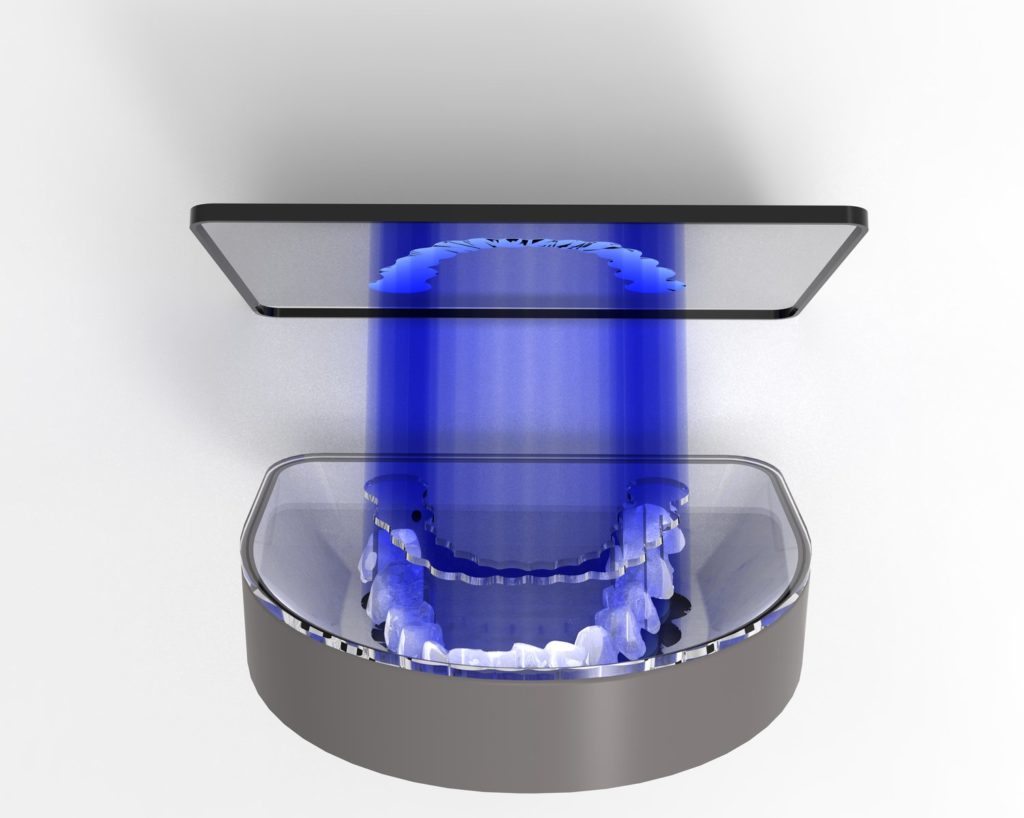The company claims that its process is 100 times faster than existing 3D printing techniques, which compares to many of the emerging volumetric 3D printing methods. Vitro3D also hopes to print larger, high-resolution, and complex components using resin cartridges, which will eliminate resin handling. Other goals of the startup include the development of a broader range of material properties currently available, as well as the production of parts that require minimal post-processing. Vitro3D aims to focus on producing dental aligners and, interestingly, scaffolds for tissue engineering.

A rendering of Vitro3D’s process used to 3D print a part for the dental market. Image courtesy of Vitro3D.
“Vitro3D’s volumetric 3D printer will disrupt how complex and custom products are manufactured in the future. The speed and detail of the products they can produce has broad applicability across multiple industries and we are excited to work with this great team,” said Mark Lupa, General Partner of Buff Gold Ventures.
“Our proprietary volumetric 3D printing technology leverages novel algorithms, proprietary hardware and materials science allowing us to disrupt industries such as dental aligner manufacturing. This funding will enable us to demonstrate the power of our revolutionary 3D printing technology, which offers the potential to change the way complex structures including intricate custom medical products will be rapidly manufactured,” said Dr. Camila Uzcategui, CEO of Vitro3D.
The Emergence of Volumetric 3D Printing
It is early days for the firm and we will no doubt learn more about its technology and capabilities as time goes on. Volumetric 3D printing is a burgeoning area with a lot of promise. In most cases, it is still at the research level, but there are companies like xolo and Readily3D that have begun commercializing the technology. Vitro3D has yet to publish a video showcasing the process, but it has to be seen to be believed, so we’ve included one from Readily3D below:
Printing the whole part in one go seems so much more logical than dancing around the outline of an item, layer by layer with a laser or galvo. But, we don’t yet know how this technology will perform in the real world. It seems so probable that this new form of vat photopolymerization will overtake existing ones, like stereolithography (SLA) and digital light processing.
The truth may not be so straightforward, however. In applications like clear dental aligners, there are number of companies that are set in their ways. They already have fleets of 3D Systems, Asiga, or EnvisionTEC systems that have been running for years. Some of these firms make up to a quarter of a million aligner molds per day, performed with a material set and process that has been locked in for years. Others have long since switched to very low-cost materials.
Even if this process is faster, it may not make sense for companies to switch, the increased machine productivity may not offset the resin cost. If the material is more expensive, the cost per aligner may be more. The fact that they tout a cartridge as being a better handling solution may also point to a captive model, whereby they want people to only use their resins. If this is true, then adoption will be slowed because companies will not want to be restricted to a single supplier and material. This has also led to lower growth expectations.
Of course the founding team seems credible, being made up of to Boulder SLA researchers. Perhaps they have something exciting up their sleeves yet. Reduced post-processing is one element that does catch my eye because that could make a difference for some applications, but more so in hearing aids than aligners. There are also developments in direct aligner 3D printing to worry about.
I’m skeptical of any application that uses SLA parts in the mouth for a longer period of time because of the potential for leeching harmful materials, as well as issues with skin sensitization and more. However, if companies can develop a flexible and safe clear aligner, then this would be far cheaper than creating a larger machine for high volume production. I understand that the aligner market is an exciting one for investors because of the volume but I’m not sure how a new technology will make a difference here. Also, I think that, in terms of the set up, it will be a completely different market than Vitro3D’s other target: scaffolds for tissue engineering. To me these two approaches would require very different clients with very different requirements. All in all, it’s very early days yet and we shall have to see what this startup demonstrates to the market in the years to come.































